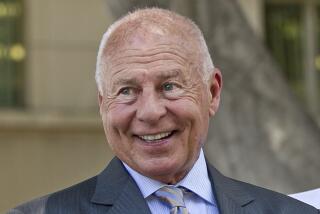Big Part of $21.1-Million Award in BofA Case Going to Attorneys
- Share via
Lawyers will split $5.1 million of a $21.1-million award to BankAmerica shareholders if a federal judge approves the proposed settlement today of four class-action lawsuits accusing the banking company of mismanagement.
The remainder of the money would be shared by 10,000 to 20,000 people who purchased BankAmerica stock between March 8, 1984, and Aug. 1, 1986, a 29-month period when the company was accused of concealing the scope of its financial problems.
San Francisco-based BankAmerica is the parent of Bank of America, the nation’s third-largest bank and the biggest in California.
The class-action civil lawsuits were filed in the middle of 1985, after the banking company reported the first of what became a record series of losses. At roughly the same time, a series of related civil actions, called derivative lawsuits, was also filed against the bank in federal court here.
A comprehensive settlement of both sets of lawsuits was announced in January between BankAmerica, its primary insurer, Employers Insurance of Wausau, Wis., and attorneys who brought the suits.
U.S. District Judge William D. Keller in Los Angeles has scheduled separate hearings on the proposed settlements today. He is expected to approve the overall terms, but lawyers involved said Keller may not decide immediately on how much to pay the lawyers.
Florida National Bank of Jacksonville, Fla., a BankAmerica shareholder, has objected to the fees as too expensive. The bank’s lawyers asked the judge to reduce the fees.
The $21.1-million settlement of the class-action suits puts a cap of 25% on the amount lawyers could seek for their fees. The amount lawyers are seeking represents 24.9% of the settlement and includes hourly rates of up to $315. The money would be deducted from the money available for shareholders.
The lead attorney for the plaintiffs suing BankAmerica in the class-action suits was Richard D. Greenfield, a lawyer from Haverford, Pa., who has gained a reputation for successfully attacking big banks.
His law firm recently filed a similar lawsuit against First RepublicBank of Dallas. The Federal Deposit Insurance Corp. recently loaned First RepublicBank $1 billion to keep it afloat while a long-term solution is sought for its financial problems.
The derivative lawsuits against BankAmerica were settled for $39.25 million. The insurance company will pay that money directly to BankAmerica. The bank will pay $5.4 million of it, about 14%, to a different group of lawyers who handled the derivative suits.
Settlement Called Fair
The judge can determine how much money is fair for the lawyers in both cases. The amount depends on the complexity of the case, the time and expense involved. Lawyers generally undertake such cases without the assurance of any fee in the event they lose the case or fail to reach a settlement. As a result, they are allowed to multiply their normal fees to cover the risk.
An expert hired by the plaintiffs said reasonable damages if the case had gone to trial would have been between $80 million and $120 million. But the lawyers said in court documents that the complexity of the case meant there was no certainty that they would win if the case went to trial. The brief said $21.1-million settlement was fair, and no shareholders have filed objections to the amount with the court.
After the legal fees are determined and deducted, the remainder will be parceled out to shareholders who bought BankAmerica stock during the 29-month period. The amount will be calculated on the basis of the stock purchase price compared to the price at the end of the period covered by the lawsuit, Aug. 1, 1986.
An administrator has been appointed to handle the disbursement and claim forms can be requested by writing to: Claim Administrator, BankAmerica Securities Litigation, P.O. Box 798, Plymouth Meeting, Pa. 19462.
The settlements contain a routine provision in which BankAmerica denied any wrongdoing, and its lawyer said earlier that the agreements will end costly litigation and provide the bank with a net recovery.
During the discovery process in the suits, BankAmerica turned over hundreds of thousands of pages of documents and 12 of its executives or former executives provided sworn statements. However, Keller issued an order sealing the material, so most of the story has remained untold.
Loan Portfolio Expanded
A 58-page brief filed by lawyers in the class-action suit outlines the case against BankAmerica from the point of view of the lawyers. It provides little new information about goings-on at the bank during the crucial period but paints a now-familiar portrait of a bank where rapid loan growth outstripped controls over loan quality.
From 1977 to 1981, the document said, the bank almost doubled its portfolio of fixed-rate residential mortgages to $14.8 billion, doubled its agriculture lending to $1.7 billion, quintupled its construction lending to $2.8 billion and extended more than $9 billion in foreign loans.
At the same time, responsibility for monitoring the loans was dispersed among approximately 100 loan committees, with as many as 15 signatures required for a single loan, the brief said, leaving no one with ultimate responsibility.
The lawsuits charged that the bank executives had been reckless and imprudent in failing to monitor the loans. But the brief softened that view considerably, saying no “overwhelming evidence” was uncovered to indicate that the bank’s loan problems were “intentionally understated.”
More to Read
Inside the business of entertainment
The Wide Shot brings you news, analysis and insights on everything from streaming wars to production — and what it all means for the future.
You may occasionally receive promotional content from the Los Angeles Times.









